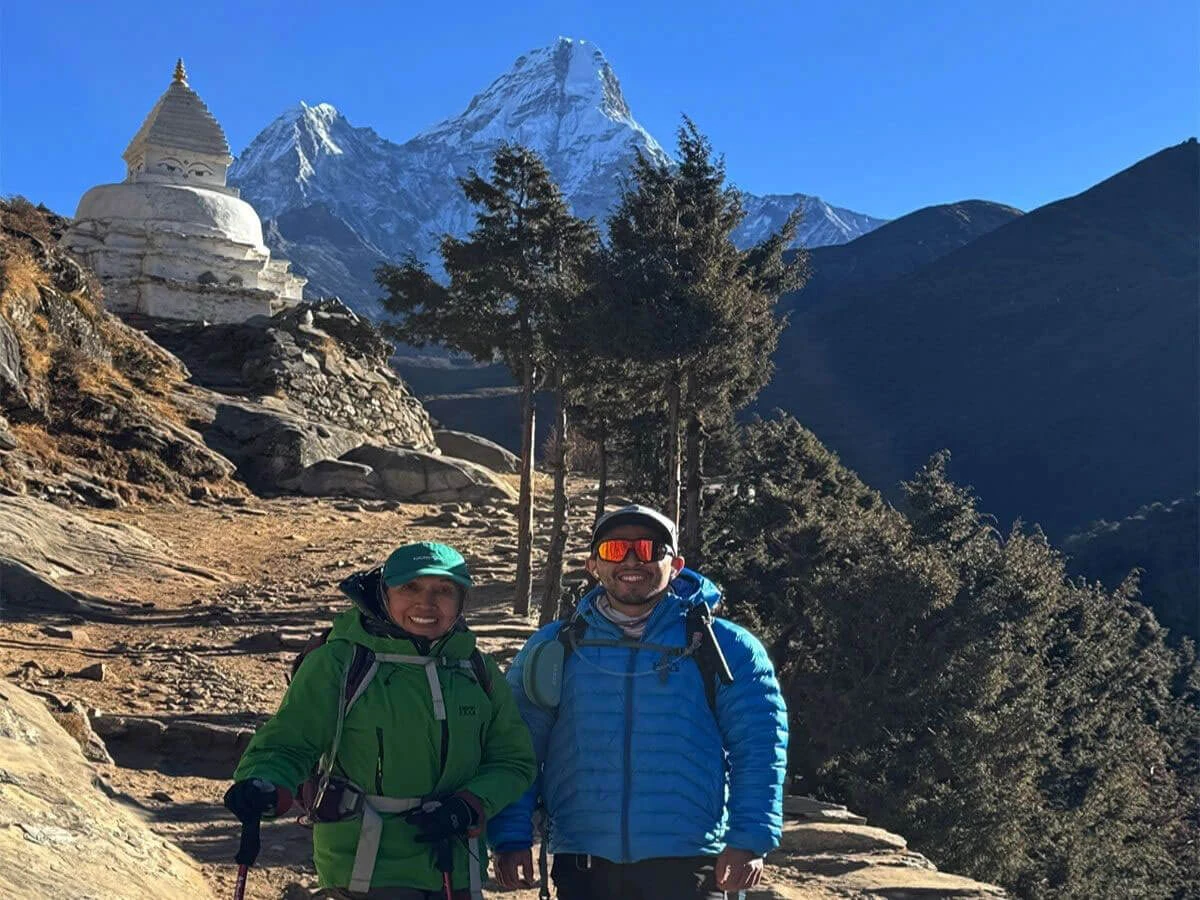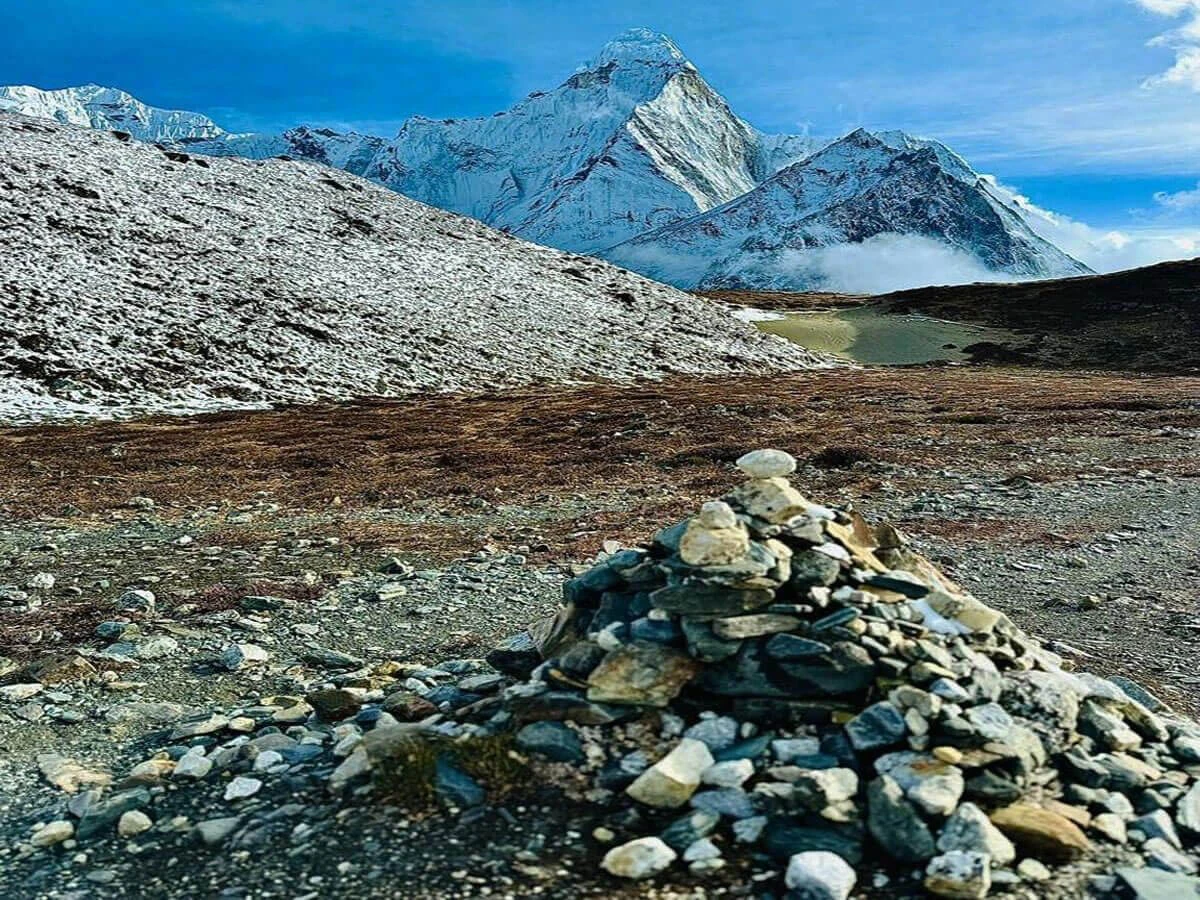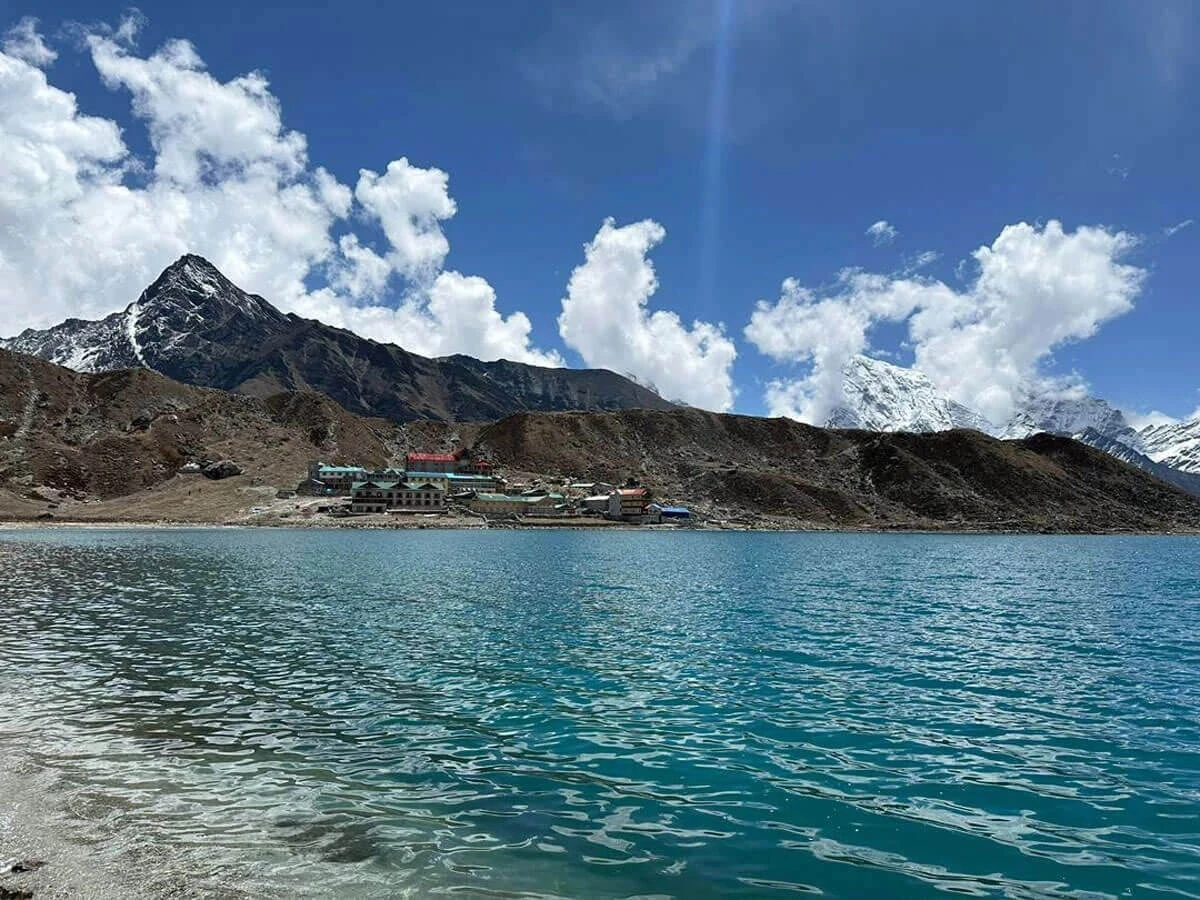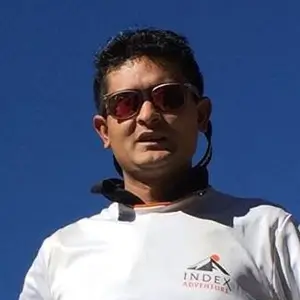Everest 3 High Passes Clockwise Trek is an ideal trekking package for anxious adventure seekers. The Everest three high passes treks encompass you through Renjola pass (5,340m), Cho La pass (5,420m), and Kongma La pass (5,535m), offering breathtaking vistas of iconic Himalayas and unbound natural beauty. This three-high-passes Clockwise trek to the Everest region is bound to enlighten your trekking experience naturally and spiritually.
Everest 3 High Passes Clockwise Trek -18 Days
Major Highlights of Everest 3 High Passes Clockwise Trek
- Everest Base Camp ( 5,364 meters).
- Three High-altitude Passes: Renjo La Pass (5360m), Chola Pass (5420m), and Kongma La Pass (5535m),.
- Sunrise from Kalapathar and a 360-degree panoramic view of the magnificent mountains like Mt. Everest, Nuptse, Lhotse, and Mt. Pumari.
- Gokyo Ri (5367m) and Gokyo Lakes.
- Namche Bazaar ( gateway of the high Himalayas).
- Explore Sherpa culture and lifestyles.
- Tengboche Monastery & Pagodas.
- Green Lush diverse vegetation and stunning Landscape.
- Khumbu glacier and Ngozumpa glacier.
- Lukla Airport ( One of the world’s highest airports).
- One of the world’s highest airports is in Lukla, which is in Nepal.
Everest 3 High Passes Clockwise Trek -18 Days
Throughout the Everest 3 High Passes Clockwise Trek -18 Days, you'll see Sherpa settlements with their culture and traditions. You can frequently see monasteries, stupas, chortens, Mani Walls, prayer flags, and prayer wheels the entire time. You'll find animals like snow leopards, Himalayan tahrs, and blue sheep, and also musk deer, colorful Himalayan monals (a type of bird), and Himalayan vultures.
And plants like mosses and alpine grasses at high altitudes, with rhododendrons. Also, you will be stunned by the beautiful landscape with glaciers in the Everest Region.
The Everest Three Passes Clockwise Trek begins with a flight from Tribhuvan International Airport (TIA) to Tenzing-Hillary Airport in Lukla (2,840m). On the same day, you'll start the trek towards Phakding. After crossing several suspension bridges, including the Hillary Suspension Bridge over Dudh Koshi River, you will enter the Sagarmatha National Park area in Monjo Village. You will see a permit checkpost where you will register your permit. Then, finally, you will reach Namche Bazaar.
You will stay one more day at Namche Bazaar for acclimatization and explore the village. As it is a Sherpa settlement, you will be seeing Namche Monasteries and museums: Sherpa Culture Museum, Sagarmatha National Park Museum, and Sagarmatha Next museum. You can also explore Everest Hotel Viewpoint, Hillary School, Khumjung monastery, Sangbouche Airport, and many more.
The trail then descends to Thame Valley. Just before reaching Thame, you'll pass a small hydroelectric plant. The trail leads you to the picturesque village of Thame, located west of Namche Bazaar, where you'll experience the charming Sherpa culture. In Thame, you can visit an old monastery that is believed to be over 500 years old.
Early the next morning, you'll walk up to Marlung village and go to Renjo La Pass. You'll cross the first of the three high-altitude passes. From Renjo La, you’ll see the beautiful Gokyo Lakes and amazing views of the mountains to reach in Gokyo Valley with Lakes. You'll head to the stunning Gokyo, where you can see the massive Ngozumpa Glacier. You'll also enjoy the beautiful turquoise Gokyo Lakes. The morning hike to Gokyo Ri at 5,357 meters the next day is a highlight of this adventure. From there, you’ll get a panoramic view of the world’s highest mountains, Mount Everest (8,848m), Cho Oyu(8,201m), Mount Lhotse (8,516m), and Mount Makalu (8,463m).
After another, you’ll be crossing the second high-altitude pass, Cho La Pass (5,420m / 17,783ft), which connects Thagnak and Dzongla. The path can be slippery, requiring extra caution. This pass provides spectacular views of Ama Dablam and Cholaste.
The next day is very important as you’ll reach Everest Base Camp from Gorak Shep. From the destination, you will see Khumbu Glacier - the world's highest altitude glacier at 4,900m (16,100ft). After enjoying the view from the top of Mount Everest Base Camp, you will return to Gorak Shep. Early the next morning, you'll hike up to Kala Patthar (5,555m / 18,208ft) to watch the sunrise and enjoy a 360-degree view of stunning mountains like Mt. Everest, Nuptse, Lhotse, and Mt. Pumori. Afterward, you'll return to Lobuche.
The day after, you'll cross the last of the three high-altitude passes, Kongma La Pass. It offers stunning views of the surrounding peaks, including the south face of Lhotse, Amadablam, and the Makalu range. Then continue your ascent toward Chukhung Village.
The next day, your trek continues to Dingboche, a place known for its stone-walled potato fields and alpine pastures. On the way, we'll walk through lush forests filled with rhododendron, pine, and oak trees. The paths become more challenging, and you'll begin to gain altitude. From Dingboche, you can enjoy views of two beautiful mountains: Ama Dablam and Island Peak. You'll resume your trek by heading to Tengboche. There, you'll visit Tengboche Monastery, which is the largest monastery in the Khumbu region.
Next, you'll head back to Namche Bazaar and follow the same path to Lukla. From Lukla, you’ll fly back to Kathmandu the next morning, ending your beautiful Everest 3 High Passes Clockwise Trek -18 Days.
Best time for Everest 3 High Passes Clockwise Trek
The best trekking season for the Everest Three Pass trek is Spring (mid-March to mid-June) and Autumn (mid-October to late December). Both seasons have stable weather and moderate temperatures. Trekking to the Everest region during these seasons under a clear sky, through lush forests and wildlife, offers a breathtaking experience for all trekkers.
Note: Monsoon season is not suitable for trekking due to Leeches, muddy trails, and a cloudy atmosphere, but it is slippery and dangerous as well. In the winter season, the trail might be blocked cause heavily more full of snow and full of ice.
Conclusion
In conclusion, the Everest Three Passes Trek is the ultimate adventure for those seeking a challenging yet rewarding experience in the Everest Region.
Over 18 days, trekkers will cross three iconic high-altitude passes: Renjo La——Cho La —and Kongma La, while enjoying breathtaking views of the world's highest mountain, Mount Everest, and other mountains. This trek offers a unique opportunity to immerse yourself in the natural beauty, rich culture, and warm hospitality of the Khumbu region. For thrill-seekers, the Everest Three Passes Trek promises an unforgettable journey of a lifetime.
Important Note: The Weather in Everest is unpredictable, so there is a high chance of delays as well as cancellation of the scheduled flight. The rate of flight delay and cancellation is high at Lukla. During your journey, if a flight cancellation happens, you have to spend an extra night at Lukla/Ktm (if you are coming back to Kathmandu or going to Lukla). So, we request that to spare a couple of days if you are planning to trek in the Everest region so that you will not miss your international flight. Helicopter rescue can also be an option, but it costs more.
Everest 3 High Passes Clockwise Trek -18 Days Itinerary
Everest 3 High Passes Clockwise Trek -18 Days
Everest 3 High Passes Clockwise Trek -18 Days is an ideal trek for adrenaline rushers as it passes you through 3 high passes of the Everest region: Renjo La pass (5,340m), Cho La pass (5,420m), and Kongma La pass (5,535m), bestowing sheer mountain vistas along with immense natural beauty. This 18-day-long trek initiates from Lukla and reaches Namche Bazaar (3,440m). From Namche Bazaar, we will pave our way towards Renjo La pass trekking through Marulung. Afterward, we will hike towards Gokyo Ri and then to Cho La pass via Thaknak. As we continue our trek further, we will trek to Gorak Shep, passing through steep rocky trails and finally reach our destination, Everest Base Camp, encompassing bizarre trekking trails and alluring landscapes. From Everest Base Camp, we will hike up to Kala Patthar (5,545m), which is the highest point of our trek, and the views are more exciting from here. We will then descend to Lobuche and trek uphill to Kongma La pass and follow our way back to Lukla.
Once you arrive in Kathmandu, our representative will receive you at the airport and help transfer you to your hotel. At the hotel, you can take some time to rest and freshen up. After you meet your guide, who will give you insight into your Everest High Three Pass Trek. Check that you have all you need for the trek. You can make last-minute purchases at Thamel. In the evening, you can explore the bustling tourist hub in Thamel.
After a 25 minute flight, brace yourselves to land at one of the world’s most dangerous airport. This notorious airport is the only gateway to the Himalayas, with hundreds of flights every day. Commence your trek to Phakding, as you come across several Sherpa villages. Along the way, immerse yourselves in the local culture.
Today, you will trek to Namche Bazaar, the commercial hub of the Khumbu region. During your journey, you will hike across several Sherpa settlements along the Dudh Koshi River. After you have reached Monjo, you will enter the Sagarmatha National Park. You need a permit to enter the park, which your guide will manage for you.
You continue toward Namche Bazaar, where you will encounter rugged paths and the Tenzing-Hillary suspension bridge, which is one of the tallest bridges in Nepal. Before reaching Namche, you will be greeted with streets lined with tiny chortens and prayer wheels. You can get a feel of the Sherpa culture and tradition as you immerse yourself in the ambiance of the high-altitude town.
You need to acclimate when you are traveling in a high-altitude region to allow your body to cope with the changing atmosphere. As a result, we have a day dedicated to acclimatization. However, there are still hiking and exploration possibilities. Today, you can visit the Sherpa museum and learn about the history of mountaineering in Nepal. A short hike to the Everest View Hotel is another activity you can get into for breathtaking views of Mount Everest, Lhotse, and Ama Dablam. Head back to Namche Bazaar for an overnight stay.
Our routes take us along the Bhote Kosi River, where the first village that we will come across is Phurte, to Thame Village, located west of Namche Bazaar. In Thame, we’ll visit an old monastery that is over 500 years old. This village, known as the "Everest Summiters' Village," is the birthplace of Kami Rita Sherpa and home to many other legendary mountaineers.
Everest 3 High Passes Clockwise Trek starts from Thame north to Marulung. It is a lead walk along the path that leads to the Marulung above the Bhote Kosi River. And we arrive at Marlung Village & finally to Lungden, the destination for this day. In our spare time, we can visit Nakpa Valley, which was once a historic trade route to Tibet. Additionally, we can also hike to Cho Relmo Lake.
Today is going to be one of the ne plus ultra moments of the entire trip. As we get closer to the fantastic Renjo La pass, the panoramic view will leave you aghast and open-mouthed. Today's trail has plenty of stunning views in store for us. The turquoise blue and crystal clear waters of Longpongolake, TabocheTsho, and Dudh Pokhari await to mesmerize you. As we walk past the Dudh Pokhari, we finally get to the Gokyo Lake. We’ll call it a day as we admire the panoramic views of the Lhotse, Makalu, Cho Oyu, and several other pinnacles.
As we get to the top, the aerial view of the Himalayas cradling the Gokyo Lake is eye-popping. We have yet 2 more lakes to encounter and explore. The panoramic views of the Himalayas will leave you in awe. Also, get a chance to view the largest glacier in the world, the Ngazumpa glacier. We hike back down to Gokyo and call it a day.
After a good breakfast, we begin our trek to Thaknak. The route mostly consists of flat and gentle trails, making the walk smooth and easy. Mostly, we walk around and across glaciers, and we witness Tabuche and Cholatse moving just beside us.
Today’s destination consists of the toughest trails compared to the trails of the overall journey. The trails are steep and have slippery, icy patches that make the walk very challenging. However, slow and steady steps will surely take us to our destination. Our guide will motivate and help you through this difficult trek. Cho La is one of the highest peaks, and we can see many prayer flags on the route. As we move further up, we witness the tiny settlements on the horizon far below. The pass gets narrower, which makes it hard for us to walk. But after we cross the pass, the trails are mostly downhill and can get slippery in the afternoon as the ice melts. Slowly, we reach Dzongla, a small village with very few lodges.
Today's trek is relatively short but definitely a groundbreaking one. A once in a lifetime experience will take you through trails between mountains that seem to be sandwiched together. Along the way, say hello to the Dughlalake. Upon getting to Lobuche, enjoy the views of the stunning peaks, particularly the Tawoche and Nuptse.
After a warm meal, we begin our trek to one of the most popular places of our adventure. The trek is quite exhausting today, not because it contains any challenging trails but due to the high elevation. The trail is flat, wide, and easy to walk on. The trail only becomes tough as we reach Gorakshep and walk towards Everest Base Camp. Trekkers must take extra care as the trail is rocky and might be slippery at times. Depending on the weather, trekkers may witness avalanches and glaciers on the other side of the Khumbu glacier. After we arrive at Everest Base Camp, we take a few pictures, rest, and walk back to Gorakshep.
The expedition begins with a hike in the dark to catch a sunrise view from Kalapatthar. Watch out for the icy trails, as they can be quite dangerous. A majestic sunrise view over the snowcapped mountains welcomes us, and we stop to click a few more pictures. As we walk back to Lobouche, the trail is mostly downhill and flat.
Not everyone dares to set foot upon the challenging trails of Kongma La. Upon getting to the world’s most stunning mountain land, you will enjoy the panoramic views of few of the highest peaks. Later, we make our way downwards to Chhukung, where we spend the night.
As we get nearer to Tengboche, our eyes face the greenery and we are in the vicinity of some refreshing trees. Along the way, we will have an encounter with the exquisite Tengboche monastery. A quick tour of the Tengboche monastery is ensured to uplift our spirituality and enhance our bliss.
As for today, we head back to the ever-so enchanting Manjo. After the 6-hour trek, explore what you couldn’t see at the beginning of the trek. An excellent way to celebrate the completion of your trek is by chilling at one of the several bars.
Today, we make our way to Lukla. Gear up and let's promise ourselves to make the most out of our last trek. As we walk along the narrow terraced trails where yaks, porters, and locals walk about, visual fragments of our entire trip come alive in our minds.
We end our trip with the infamous 25-minute terror flight from the Tenzing Hillary airport to the hustle and bustle of Kathmandu. Gaze and thoroughly paint the views of the Himalayas on your mind for one last time.

Cost Details
Includes
- International airport pick up and drop off by private vehicle.
- 2 Nights 3-star Hotel in Thamel, Kathmandu with BB Plan.
- Both-way domestic flight ticket (Kathmandu -Lukla- Kathmandu) including airport transfer to the domestic airport ( Note: Domestic Lukla flights will be diverted from Ramechhap Manthali due to Big seasons such as April to May & October to November.
- Ground transportation in a private vehicle as per the itinerary
- 15 nights' Trekking lodge / Teahouse accommodations during the trek(twin sharing).
- 3 times meals a day (Breakfast, Lunch, and Dinner), a cup of tea or coffee during the trek.
- Government register expert with a professional English-speaking trekking guide, including accommodation, food, transportation, equipment, and salary.
- All necessary paperwork and Sagarmatha National Park entry permit, Pasang Lhamu Rural Municipality Entrance Ticket, including local Tax, Government tax & official expenses.
- (if needed) Sleeping bag, down Jacket & Duffel Bag (to be returned after trip completion).
- Duffle bag, and a company T-shirt (complimentary).
- Free luggage storage at the Index Adventure Store.
- Farewell Dinner & Trekking Achievement Certificate.
- Exclusive Medical Kit Bag.
Excludes
- International airfare, all kinds of travel insurance, and the Nepal visa fee. (You can apply online, or you can easily issue the visa on arrival at the International Airport in Kathmandu. ( For a Nepal Visa, 15 days - $25-30, 30 days- $40-50and 90 days- $100-110).
- Extra nights' accommodation & lunch, and dinner in Kathmandu city.
- Personal expenses such as all kinds of drinks, hot showers, battery charging, extra meals, and wifi laundry.
- Travel and rescue insurance (necessary).
- Additional Costs or delays caused due to Circumstances beyond our control. Example: bad weather conditions, landslides, illness of government policies, strikes.
- Porter to carry your luggage during the trek. If you would like to take a porter, you can check our Add-ons Details option.
- Tips for guides and porters.
Add-ons & Options
Porter Service - US$295
Hiring a skilled porter in the Everest Three High Passes Trek at this rate will give the much-needed support to your whole trip. Each porter can carry up to 25 kg of equipment (mostly a duffel bag), allowing you to travel light and not worry about heavy baggage. When traveling with another person or friends, one porter has to be shared between two, effectively dividing the load to approximately 12.5 kg per person.
Kathmandu to Lukla Heli Flight at US$400 to US$500
Lukla serves as the starting gateway for treks in the Everest region. An option is a 45-minute helicopter flight out of Kathmandu, which is extremely picturesque and quick, but can cost around US$400 per seat on a shared flight. Every helicopter can hold a maximum of five passengers and a combined luggage weight of 450 kilograms.
Lukla to Kathmandu Helicopter Flight - US$400 to US$500
On the way back to KTM, after the completion of the trek, you are likely to take a helicopter ride between Lukla and Kathmandu, which will be a fast and comfortable 45-minute journey. It is 400 USD for a shared flight.
Upgraded Accommodation - US$150
This upgraded option enhances your trekking experience with added comfort. It includes one night in Phakding, three nights in Namche, one night in Tyangboche, two nights in Dingboche, and one night in Lukla. Each upgraded room includes an attached bathroom for greater convenience.
Everest 3 High Passes Clockwise Trek -18 Days Route Map
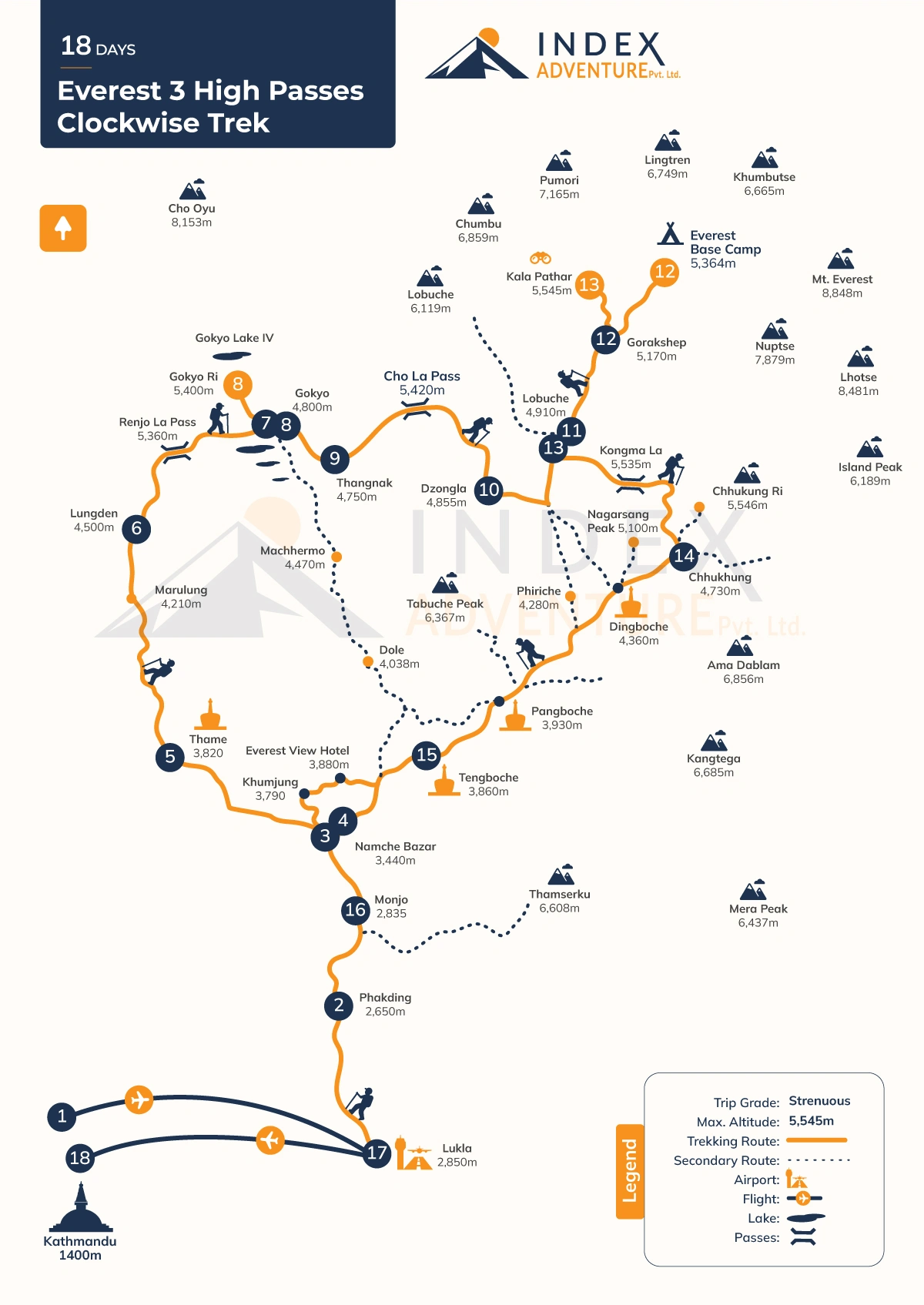
Altitude Chart
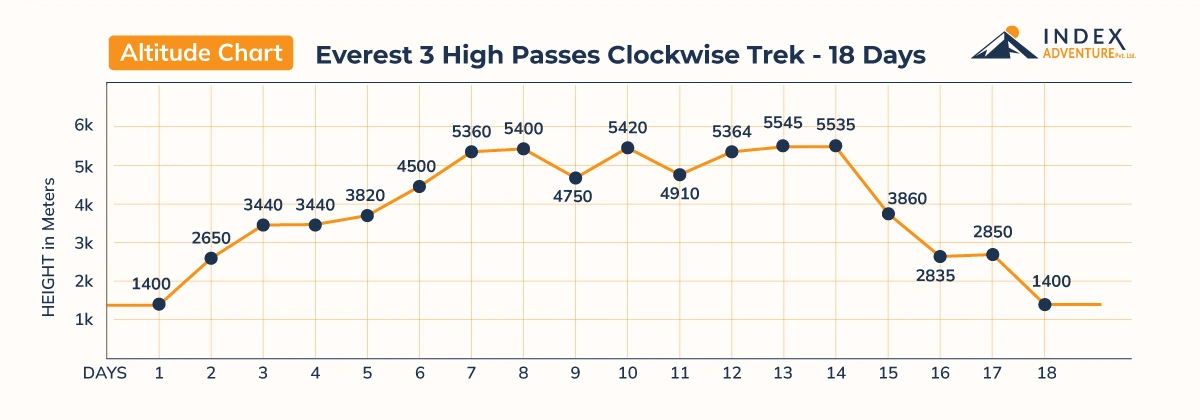
Equipments
Things to Pack for Nepal Trip and Trek
What should be on your packing list for trekking, in case you are going on an adventurous trekking tour to Nepal? Nepal has one of the most magnificent scenic views, spectacular mountains, and cultures, and therefore, the country is a dream global trekking destination. Before trekking in Nepal, one needs to be well prepared because of the different terrains, weather conditions, and altitudes. In order to get the best out of your trekking visit, this ultimate packing guide of trekking in Nepal will cover all that is essential: a list of items you could carry with you, clothes, supporting trekking gear, hygiene, documents, etc.
Preparing to go trekking in Nepal can be very overwhelming, but with the right gear and equipment, you should be in a position to withstand anything that the path presents to you. This is a list designed for popular treks that include Everest Base Camp, Annapurna Circuit, Langtang Valley, etc., and it can be altered depending on the trek difficulty and season. This latest and updated travel checklist to pack smart—and trek with confidence.
List of essential packing items
In the trekking, there are thousands of trekkers using costly fashion equipment, and they use outdoor fashion, but we advise you to be ready with hiking equipment that is comfy and sturdy.
- Insulation Layer (Fleece/Down Jacket): Will be needed during cold weather.
- Thermal Base Layers: Help to keep the body warm when it is cold or when it comes to high altitude.Your second actual skin; bring the highest quality (2 sets).
- Fleece Pullover Hoodie: a garment that keeps you warm even when the water condenses on the inside when it is raining. Taking two, both at low-level and at high-level, comes in handy.
- Lightweight Thermal Tops: This is cool when you do not wear a base layer.
- Water, Rain, and Snowproof Outer Shell: recommended to use water, rain, and snowproof (in case of bad weather).
- Hiking Shorts(Optional): They can be good in lower altitudes and on sunny days.
- Hiking T-Shirt (2-3): convenient, breathable, fast-drying tops to wear every day. At a lower altitude.
- Trekking Pants ( 2-3): Loose, comfy pants, flexible, to be comfortable on the trail. Lightweight, quick-drying paints (no jeans, please).
- Down Pants: Bonus heat at night or at a high altitude trek.
- Liner + Insulated Gloves: Cold hands will be kept warm and will be isolated from wind and snow. Should take two light ones and a heavyweight water/windproof. Cold hands will be kept warm and will be isolated from wind and snow.
- Sports Bra for Girls: When you are hiking, a good sports bra should be considered.
- Sportswear Underwear(5-7 pieces): Moisture-wicking to avoid annoyance and irritations, Quick dry.
- Woolen Hat: This will come in handy when it is starting to get cold in the evenings and in the morning hours to keep your head warm.
- Sun hat/ Cap: It protects one against the Sun at high altitude.
- Neck Gaiter/ Buff: Very useful in the sun and dust or cold wind.
Footwear for Hiking in Nepal
- Trekking Socks (3-5 pairs): These socks are meant to lower the possibility of blisters and visible processes that take a short duration to dry.
- Warmer Socks (1-2): Wear during sleep or in an unfavorable climate in cold weather.
- Trekking boots: A pair of sturdy, already used and comfortable, up-to-the-ankle boots made to provide support, traction, and repelling during mountainous and rough trail activities.
- Trail Running Shoes: These are breathable and lightweight and are ideal when on more maintained paths or elevations, where the shoes do not need tough materials.
- Camp Shoes/Sandals: It is convenient, comfortable, and wearing shoes that are worn to house overnight camp or river crossing after a strenuous day of trekking.
- Gaiters (Optional): These cover over the boots so that one is protected against the snow or rain, or on muddy footpaths, dirt will not enter the shoes.
- Crampon-compatible Boots: In case you are planning to trek into high-altitude or glacier-covered parts, then crampons are a must on icy surfaces that cannot be fitted into just any boot.
Gears and Equipment for trekking in Nepal
- Packing a Backpack 30-50L on a personal basis: Its contents include items such as clothes, snacks, and water that may be carried around during the day.
- Duffel Bag 70L: A Larger bag used to carry most of your equipment, which must be waterproof. It should be recommended only when you are going to use Porter.
- Daypack with Rain Cover: A day pack is also essential on your trekking adventure in Nepal, regardless of whether you are carrying a porter or not. Day pack size recommendation is 25-30L with a rain cover, which keeps water and snow out of your pack and contents.
- Sleeping Bag Liner ( -20 °C.): Also, it is highly advisable to bring your own after coming from a sleeping bag, and in case you plan to rent a sleeping bag. Insulates and makes your sleeping bag less in need of washing.
- Trekking Poles: This is optional, though being knowledgeable of their use will help lessen the burden on the knees and enhance steadiness on inclined or uneven ground.
Accessories for trekking in Nepal
- Extra Batteries Headlamp: These can be used on early morning walks, during power failure, or when one arrives late.
- Water Bottles / Hydration Bladder: Makes you hydrated; it is easier to drink on the move as the bladder can be sipped from. Plastic waste can be reduced through the use of a reusable water bottle.
- Water Purification Tablets or Filter: Garfores are the local sources used in providing safe drinking water.
- UV Protection Sunglasses ( UV Protection): Cover the eyes against excessive sun and snow lights.
- SPF 50+ sunscreen/SPF lip balm: Avoids sunburn and dry lips, too.
- Towel (Quick-dry): To wash, or wipe at teasssshouses or streams.
- Toiletries: (Eco-friendly): Toothbrush, toothpaste, a sheet of toilet paper, and biodegradable soap.
- First Aid Kit (Personal): Covers the essentials of bandages, an antiseptic, altitude medication, pain relievers, and any particular medication you might need.
- Snacks ( Energy Bars, Nuts, Chocolates ): Come in handy to provide instant energy when hiking hours are long.
- Notebook and Pen (Optional): To journal or document life.
- Trash Bags: Carry some trash bags to pack and dump your waste, and keep them clean.
- Phone Charger: Have a fully charged cell phone and car charger.
- Power Bank: A power bank means that your gadgets do not run out of power.
- Local SIM Card: Buy a local SIM card (NTC or NCELL) that will enable you to connect well in distant regions.
- Cash (Around 25k to 30k NRS): Keep some cash along with that, which will help you take care of the expenses because on the trek route, ATMs may be few.
- Map and Compass / GPS: Always bring the appropriate geographical tools to prepare yourself.
- Camera and Binoculars: A camera and binoculars can be used to take pictures of the beautiful landscapes and to observe animals.
Documents for Trekking in Nepal
- Passport: Should be valid for more than 6 months, required when making identification, booking flights, checking into a hotel, and applying for permits.
- Nepal Visa (Some countries need to obtain this in their homeland): One must have a tourist visa to enter Nepal, and it can be acquired either on arrival at the Tribhuvan International Airport or online.
- Trekking Permits: Get permits of any kind that you will need when taking the particular trekking route.
- Passport-sized Photos (For now, digital and instant photos click options are available): Required by such things as TIMS (not necessary) and park entry; take about 4-6 copies
- Travel Insurance (with emergency evacuation): Highly advised when hiking in high altitude; it is necessary to insure helicopter rescue, sickness, accidents, and trip cancellation.
- Airline Tickets / Itinerary Copies: On international flights, as well as domestic flights (e.g., to Lukla, Pokhara); handy at the checkpoints, or in planning.
- Permit Payment Proof: You can be asked to show a receipt or a copy that you have paid your permits in the trails or at the entrance to the park.
- Address to use in cases of emergency: Ought to be handy or given to your trekking agency or guide.
Trekking Equipment Provided by Index Adventure
- Quality Sleeping Bags (-15 degrees Celsius rated): For warmth and comfort during the trek, especially at higher altitudes.
- Premium Down Jackets (-15 degrees Celsius rated): Provide essential insulation against the cold.
- First-Aid Kit: A comprehensive kit with necessary medications, an oximeter, and supplies for minor injuries and illnesses.
- Crampons: For traversing icy and snowy paths.
- Water Purification Tablets: To ensure safe drinking water.
